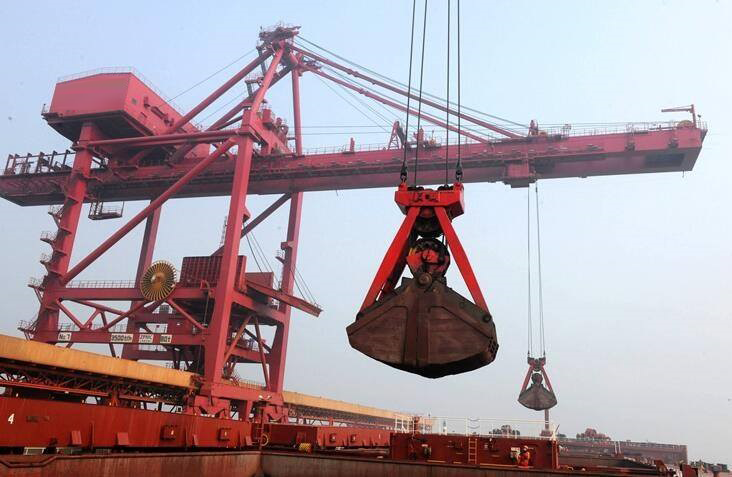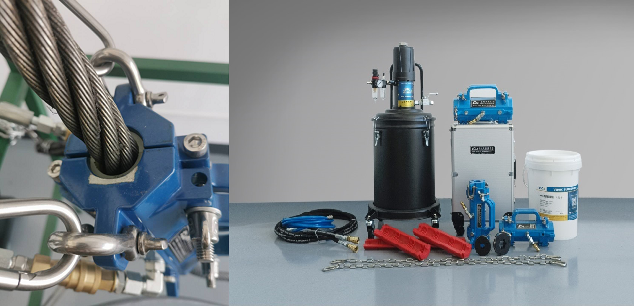Maintenance of Wire Ropes for Bridge-type Grab Unloaders

Maintenance of Wire Ropes for Bridge-type Grab Unloaders
Wire RopeThe main winding system is the core component of a bridge-type grab unloader, consisting of luffing wire ropes, hoisting wire ropes, closing wire ropes, trolley traction wire ropes, and drums/pulleys on each mechanism. Among them, the hoisting wire ropes are connected to the grab via corbel brackets, and the closing wire ropes are connected to the grab via pear-shaped/C-shaped connectors.
Working Process of Traction-type Bridge Grab Unloader
The grab picks up materials from the cargo hold → the hoisting mechanism raises the grab to a certain height → the trolley moves from the cargo hold towards the hopper → the grab opens directly above the hopper → materials fall into the hopper and from the hopper outlet into the vibrating feeder → the vibrating feeder continuously and uniformly conveys materials to the feeding belt conveyor via vibration → the feeding belt conveyor transports materials to the transfer station of the ground belt conveyor. This cycle repeats to complete the unloader's material unloading task.

Safety and Economic Analysis of Wire Rope Use
The hoisting/closing and traction wire ropes in the unloader's wire rope winding system are parts subject to frequent dynamic and static loads, serving as critical mechanisms during unloader operation. These wire ropes bear not only the static loads of the grab, materials, and their own weight but also dynamic loads caused by acceleration and impact during operation. The wire ropes repeatedly wind around drums and pulleys, cyclically承受较大的弯曲应力 (承受 significant bending stress), and bear additional loads caused by bending. Additionally, when the wire rope stretches under load, friction occurs between steel wires, between the rope and pulleys/drum grooves, and between the rope and lifting components, subjecting the wire rope to resistance loads from friction. Under these loads, the wire rope generates significant tensile and bending stresses. When the number of stretches and bends exceeds a certain threshold, the wire rope exhibits "metal fatigue", leading to wear and breakage of steel wires after a period of use. Therefore, the main issues exposed in production practice for unloader wire ropes are wear and broken wires. Notably, severe wear and breakage occur in the 20-meter section where the hoisting wire rope connects to the grab, the main working section of the trolley traction wire rope passing through pulleys, and the wire ropes inside the grab.
A wire rope is composed of multiple moving elements (steel wires, strands, core, etc.), with more or less relative movement between each element, similar to moving pairs like gears, bearings, and chains. When subjected to tension, bending, and torsion, each steel wire, strand, and core in the wire rope experiences friction and wear with each other. When passing through pulleys or other steering/pressing devices, sliding and relative friction/wear inevitably occur.
The following specific phenomena occur: Therefore, ensuring adequate lubrication of wire ropes and proper use of lubricants are crucial for extending wire rope service life. Data shows that systematic lubrication of wire ropes can extend their lifespan by 2-3 times. Regular lubrication is essential to keep them in good lubrication condition.

The VMAXX® wire rope cleaning and lubrication system effectively removes impurities adhering to the wire rope surface and uses high pressure to inject grease into the wire rope surface and core for maintenance, providing comprehensive lubrication protection.
Currently, a reasonable lubrication method for bridge-type grab unloaders is a combination of thin oil lubrication and grease lubrication. Typically, cable oil (thin oil) is applied or used for immersion to ensure adequate lubrication inside the wire rope and core, reducing wear between steel wires, strands, and the core. A layer of grease is then applied to the wire rope surface to reduce friction between the rope and pulleys/drums. The VMAXX® system enables convenient cleaning and lubrication after fixed installation, improving efficiency.

